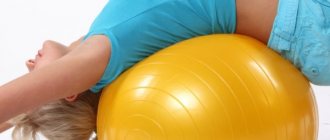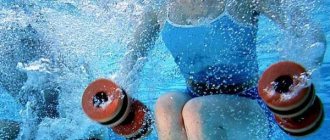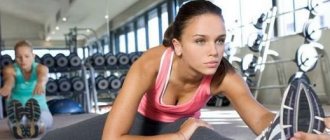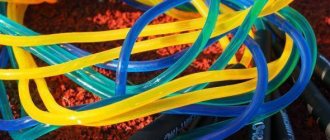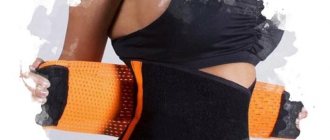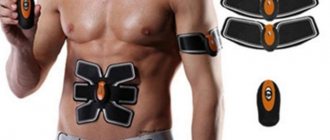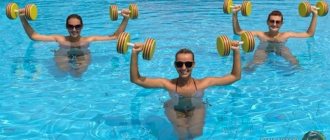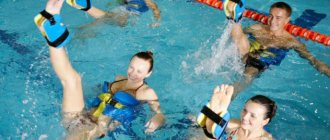- Some nuances
- Abs exercise
- Legs adjoining and spreading
- Bringing your hands together
- Footwork
- Kick or punch
In order to get yourself in decent shape, tighten your butt, make your legs slender and strong, and achieve a flat tummy, you don’t have to exhaust yourself with training on machines, with dumbbells and barbells. Come to the pool! Free swimming and fairly light exercises, which do not require any special equipment or the help of a professional trainer, will not only help you achieve the desired shape, but will also bring you pleasure.
Exercises in the pool are recommended even for those who cannot swim - do them in shallow water
The TOP 5 exercises for the pool below work out all the important muscle groups. In less than a month, your body will tighten up, become more athletic and thinner. Choose a comfortable sports swimsuit - and get a beautiful figure!
Available exercises in the pool
Benefits of exercising in water
Exercises in the pool benefit the body and are suitable for people of any age, even if they have any chronic diseases, for which exercise on exercise machines and group fitness training is prohibited. How are exercises in the pool more beneficial compared to fitness?
- Heart training. Exercise in water helps improve the functioning of the cardiovascular system. Due to aerobic exercise, tissues are saturated with oxygen, which results in increased blood circulation and cleansing of the walls of blood vessels.
- Protection from stress. There are studies that show that regular exercise in the pool and swimming help reduce stress levels and improve your mood. This can be explained quite simply: during training in water, there is an active release of endorphins, the so-called “hormones of joy.” Such training helps reduce muscle tension, reduce anxiety, and increase concentration.
- Muscle tone. Exercises in the pool have a gentle effect on the muscles, strengthening them. And, although the load is not felt as strongly as in the gym, the effect will be much better due to the constant overcoming of water resistance.
- Strengthening joints. Most types of fitness training are contraindicated for overweight people, as this can lead to injuries to the joints and spine. But exercises in the pool, on the contrary, improve the functioning of cartilage, tendons, and muscles.
There are several types of pool training. The choice of the right one depends on personal preferences, capabilities and the opinion of the doctor. Let's take a closer look at the main directions that help you lose weight.
Some nuances
Like any physical training, exercise in the pool has its own characteristics:
- Prepare yourself for the fact that you will have to work hard: only if your muscles burn and you feel tired will there be a result. Fat deposits will begin to melt, muscles will become stronger, and the skin will not sag.
- Do a lot of repetitions: usually 10-100 repetitions in 4-5 sets. When developing a complex, focus on your own physical fitness.
- Do what you can - you will move on to more complex, unsuccessful exercises when the body adapts to the load.
- Take a rest break if you are very tired or switch to another exercise.
What activities in the pool help you lose weight?
For training in water to bring results, it is important to approach it consciously, draw up a clear schedule, and follow it, taking into account the following rules:
- during the first lessons, it is better to seek help from an instructor, ask them to draw up an exercise program to work all muscle groups, explain in detail the technique and possible mistakes;
- you need to start your workout with a warm-up outside the pool: the muscles should be warmed up before immersion in the water;
- It is advisable to increase the pace gradually, the peak should occur in the middle of the lesson, towards the end it is better to switch to leisurely exercises;
- Light swimming on your back will help restore your breathing between sets;
- The training time also needs to be increased gradually: in the first week it should be half an hour, the next month - 45 minutes, each subsequent - an hour;
- classes should be regular, at least three times weekly, preferably every other day;
- You can’t eat 1.5 hours before training - this is fraught with digestive problems.
You can achieve really good results by combining training in the pool with proper nutrition. There is no need to starve or deplete the body with low-calorie mono diets. It is recommended to eat fractionally: often, but in small portions, about 4-6 times daily. It is better to exclude “harmful” foods from the diet: fried, salty, confectionery and flour products, and replace them with vegetables, fruits, cereals, dairy products and lean meats and fish.
Swimming and aqua yoga
Classes in the pool can be of varying intensity. For beginners, the ideal solution is simple swimming, combining different styles. It will help you get used to the load and prepare your body for subsequent workouts.
Another option could be aqua yoga - this is a special type of yoga adapted for classes in the pool. The exercises are performed smoothly and slowly, which is ideal for pregnant women, people with sore backs and joints. Such training allows you to relieve stress from the lower back, improve the state of the nervous system, well-being, and lift your mood.
Fitness (water aerobics)
Fitness in the pool is considered safer than exercise on machines or group fitness training, since the loads are gentle and gentle. This exercise uses a variety of equipment: dumbbells and barbells made of lightweight plastics, weights for the arms and wrists.
Water aerobics is beneficial for a number of reasons:
- helps strengthen the cardiovascular system;
- reduces body volume and visible cellulite;
- improves skin condition. An important nuance - it is advisable to choose pools in which the water is disinfected without the use of chlorine, but, for example, with ultraviolet lamps;
- strengthens the muscle frame, heals the body.
Water aerobics classes are contraindicated for people who have recently suffered a heart attack, as well as those suffering from asthma, osteochondrosis of the cervical spine caused by vascular insufficiency. Only a doctor can allow or prohibit training for such diagnoses.
Interval training
Interval training is recognized among sports supporters as the most effective. This approach alternates between high and low intensity exercises. It turns out that the body does not have time to get used to a certain type of activity, each new type causes a release of adrenaline and norepinephrine - this helps to enhance the effect.
Interval training can also be done in the pool, and there are several options:
- A combination of different swimming styles. A leisurely 10-second breaststroke can be replaced by an intense 15-second butterfly at the limit, which will again be replaced by another slow event. Just 7-10 such cycles will make you feel tired, your heart rate will accelerate, as will your metabolic processes.
- A combination of swimming and intense water aerobics exercises. In this case, the intervals can be made longer: set aside 2-3 minutes for performing strength approaches and a minute for rest - swimming.
Such training is best done under the guidance of an experienced trainer, as it significantly increases the load on the cardiovascular system, which can lead to sudden cramps.
Hand technique
Training for Beginners
For very beginners taking their first steps in freestyle, we can recommend trying two exercises at the very beginning - imitation of movements and alternating strokes with a board .
Imitation of movements while standing on the bottom
Stand on the bottom with your legs spread wide enough and one of them forward so that your body does not drift.
Try to imitate all phases of the stroke to get a feel for how they are performed. The sequence of actions is shown in this illustration:
Imitation of movements
At the same time, do not make a strong effort directly during the raking movement, otherwise you will be carried away.
Alternating strokes with the board
Take your board and start swimming with your head down, using your legs.
As you move, start doing alternating strokes:
- the hand makes a stroke,
- then she returns to the board,
- then the stroke is made with the other hand.
One hand holds the board, the other makes the stroke.
While performing this exercise, it is also recommended to practice breathing to the side.
Arm strength
Swimming with shoulder blades and/or stick
This is one of the best exercises for developing a strong stroke.
In the classic version, it is done as follows:
- shoulder blades are put on;
- a bun (or swimming board) is clamped between the legs;
- we swim only using our hands , our legs are inactive;
- Thus, depending on the level of physical fitness, we swim 50-400 meters (but if you are a beginner, do not overload your shoulders!).
The blades are described in great detail here:
The shoulder blades require much more force to rake water with them, so this method perfectly trains the necessary muscles.
Mill
Starting position: one arm is extended in front of you, the other is pressed.
Then they begin to work simultaneously: one hand makes a stroke under water, the other sweeps above the water. We work in this mode - hands change without catching up with each other.
You can see what it looks like at the sixth minute of this video:
On fists
Swim in full coordination, but at the same time clenching your fists . Try to push the water through your hand (from wrist to elbow).
This teaches the following: - “everything is learned by comparison”: after such swimming you feel much more strongly how your open palm clings to the water - we train the work of the forearm and hand
Correct stroke (wild grip)
Often when swimming, swimmers do not grip the water enough and do not bend their arm enough at the elbow to make a stroke movement.
An exercise that an author from the Silver Swim school calls “Wild Grab” .
Its meaning is to make only rowing movements underwater and, without bringing your hand through, immediately return it forward and make the stroke again.
Thus, progress is achieved only due to the stroke phases , and if you do them incorrectly, then it will be extremely difficult to swim.
Here's what it looks like:
Long stroke
Swimming with alternating hand work (“catch-up”)
This exercise allows you to focus on your arm technique and develop a long stroke.
Algorithm of actions:
You can't argue with that!
- We begin to swim with our arms extended forward;
- We make a stroke with one hand;
- We return it to its original position;
- Then we make a stroke with the other hand.
Counting the number of movements
While swimming through the pool, count the number of strokes it took you.
After that, try swimming the next pool with fewer strokes, and so on.
As a result, the fewer strokes you make over the same distance, the better you glide - you develop a “long stroke”.
High elbow
Along the track divider
The point of this task is to swim along the lane divider , but in such a way as not to touch it with your shoulder area.
In this case, the limb has to be lifted over the top. You need to lie with your right side closer to the lane separator and perform strokes with your elbow raised up. Be careful not to touch the separating element. Do the same on the left.
Bringing your hand near the divider
Holding the thumb near the ear
touch your ear with your thumb for a couple of seconds while moving your hand above the surface of the water .
Only after a delay can the limb be placed into the water.
Military salute
This is an analogue of the previous task - when bringing your hand, we deliberately touch your temple with it . In this way you can train the correct trajectory, raising the elbow.
Fingers in the water while carrying
We make a stroke, but do not take our fingers out of the water while carrying it .
Thanks to this, we gain:
- the position of the elbow is correct (it should look up);
- body rotation.
Try also leaving your entire palm and even your hand in the water.
Thumbs forward
After the hand is placed in the water, we point the thumb forward in the direction of our movement so that the shoulder, elbow (its inner part) and thumb form a straight line.
This allows you to practice stretching and get rid of a common mistake - the tendency of your hands to the center in front of you.
Lightning
After the stroke, the hand slides from the hip to the armpit and back (as if zipping and unfastening a zipper on the side), then is placed in the water.
This trains the raising of the elbow and the trajectory of insertion into the water.
Feeling the water
Take a ping pong ball or similar object with your fingers and swim with it as shown in this video:
This teaches you to feel how your hand clings to the water - while part of your palm is occupied by the ball, you should focus on clinging to the water with the rest of your palm.
A set of exercises in the pool for weight loss
Walking
The simplest exercise that can be done by anyone is walking in place. This type of load is ideal for warming up. It loads the muscles well, warms them up, and prepares them for the upcoming complex. It is necessary to go into the water approximately up to your chest and perform leisurely movements, without moving from your place, slowly raising and lowering your legs.
You can combine walking with any exercise or swimming, or use it in interval training as a rest between sets.
Lunges
Lunges are a good exercise for strengthening your hips, back and chest muscles. The technique differs little from the “ground” one:
- enter the pool up to your waist;
- stretch your arms in front of you, you can take special light weight dumbbells or clasp them in front of your chest;
- make a deep lunge forward with your left leg, fix the position for 5-7 seconds;
- return to the starting position and repeat the exercise on the other leg.
To enhance the effect, you can attach weights to your ankles. The exercise is performed 15 times on each leg, 3-4 repetitions.
Jump
The “jump” exercise is an analogue of regular jumping in place. To do this you need:
- enter the pool approximately up to your chest;
- take a stable position;
- Gently rise up onto your toes. Do not make sudden movements, as you may slip and injure your ankle;
- bend your knees slightly, make a springy movement and push your body up;
- You need to land smoothly, placing your foot on your toes on your entire foot.
It is necessary to do at least 3 sets of 15-20 repetitions. This exercise helps strengthen the muscles of the thighs, buttocks, calves, and also improves coordination.
Run
Running is a replacement for walking, a more complex version of it. It is suitable for more prepared people who have already done several workouts in the pool.
The principle of implementation is quite simple:
- you need to enter the pool up to your chest and take a stable position;
- bend your arms at the elbows, hold them near the waist;
- With an inhalation, begin a leisurely run: slowly lower and plant your feet.
It is advisable to perform this exercise with weights. This will make it easier to float on the water, although the load will increase significantly.
Jumping
A more difficult option for performing the “jump” exercise is jumping. It has several different options:
- Jump alternately on each leg.
- Jumping on both legs.
- Jump up, and when returning, you need to spread your legs as wide as possible, making a light squat.
To perform it, you also need to go into the water up to your chest, make movements slowly, gradually increasing the speed and pace.
Tilts
The “bending” exercise is probably familiar to everyone from school or even kindergarten. From a standing position, you need to do twists forward, left, right, back, at least 10-15 repetitions on each side.
Bending helps strengthen the muscles of the back, abdomen, waist and sides, which is especially suitable for women for recovery after pregnancy.
Leg raises
This is the simplest, yet quite effective exercise for those who want to strengthen muscles and increase muscle tone. To complete it you need:
- enter the pool approximately up to your chest;
- your feet should be firmly on the bottom; for better balance, you can attach weights to your ankles or take a special plastic stick;
- stand up straight, spread your legs wide to the sides;
- raise your legs alternately as high as possible to the surface of the water.
You need to perform the exercise slowly, for 2-3 minutes, raising and lowering your leg as slowly as possible: it will be more difficult to do this, but the effect will be more noticeable.
For weight loss
Water resistance puts more strain on muscles and increases energy expenditure, which is the first condition for losing weight. Any workout in water significantly helps you lose weight, especially if you use special equipment.
A set of water aerobics exercises for weight loss usually includes the following exercises:
- "Scissors".
- "Bike".
- Swing your legs and arms.
- Walking and running in water.
- Squats.
Be sure to do a warm-up - simple swimming for a few minutes. Towards the end of the workout, perform the exercises less intensely; at the very end, be sure to lie down in the water to relax your muscles.
Results from water aerobics for weight loss will appear if you do 3-4 times a week for 40 minutes or more.
Watch a video of a water workout aimed at losing weight:
Exercises for losing belly fat
Classic fitness presents many different exercises for the abdominal area. All of them help strengthen muscles and increase endurance. But, unfortunately, most of them have a fairly wide list of contraindications. Various twists and stress on the abdominal muscles, for example, are strictly prohibited for women during the recovery period after a cesarean section or for people after various surgical interventions.
A set of exercises developed by specialists for the pool can come to the rescue. Let's look at a few of the most effective ones.
Bike
To perform the exercise, you need to secure your hands to a special handrail or side of the pool. Bend your knees at a right angle, and exhale, begin movements that imitate riding a bicycle. First rotate them forward, then back, about 15-20 seconds on each side.
“Bicycle” helps strengthen the abdominal, back, and front thigh muscles.
Crunches
The crunch exercise effectively works the abdominal muscles, as well as the lower abdominal area, which usually causes the greatest discomfort in both women and men.
To do this you need:
- turn your back to the side of the pool, bend your arms at the elbows and rest them on the edge. In this case, the body should be immersed in water up to the chest;
- exhale, pull your legs to your chest, and inhale, lower them back.
Such approaches must be done at least 3, 20-30 repetitions for each.
Turns
This exercise is similar in technique to the previous one, but helps to work not only the rectus abdominis muscles, but also the obliques. This is done as follows:
- turn your back to the side of the pool, bend your arms at the elbows and rest them on the edge. In this case, the body should be immersed in water up to the chest;
- exhale, bend your knees, pull them to your chest and twist to the left, and inhale, lower them back. The body and chest should look forward, and the waist and hips should turn to the left or right side;
- repeat the exercise on each side 10-15 times.
It should be understood that accumulations of fat in the abdominal area are formed for various reasons. These may be the consequences of an unhealthy lifestyle, abuse of junk food or alcohol, symptoms of various diseases, and much more. It is important to establish the true factors behind the appearance of extra pounds, otherwise no exercise will help - the weight will return again and again, constantly increasing. Only specialists from a weight loss clinic who have a wide range of experience, a huge base of knowledge, tools and equipment can help with this.
With dumbbells
Devote a few minutes to exercises with weights, then your sides will go away faster. When performing them, it is advisable to keep your back and neck straight. Pay attention to these exercises with special dumbbells:
- Lower your hands with dumbbells down and take your starting position, standing straight in the pool. Imitate walking by raising your knees high while bending your elbows. Count to 30.
- Spread your legs wider, slightly tilt your body forward. Place your left hand with dumbbells behind your back, and stretch your right hand forward, intensively change the position of your hands. Count to 40.
- Stand up straight, legs closed. Hold dumbbells with your arms bent at chest level. Rotate your body from side to side. 20 times.
Exercises for losing weight on thighs and buttocks
The following exercises will help strengthen the muscles of the thighs, abs and buttocks. They help improve blood circulation and lymph outflow, as a result - visible cellulite is slightly reduced, the skin becomes smoother and more even.
Before performing this complex on the buttocks, it is recommended to warm up in front of the pool by doing a simple warm-up, and in the water by running or walking in place, or a leisurely 5-minute swim.
Leg circles
The exercise is performed standing chest-deep in water. You need to turn sideways towards the side, grabbing it with one hand. Raise one leg to the waist, slightly bending the knee. As you exhale, begin to perform wide movements forward and backward. There should be sensations in the buttocks, front and back of the thigh.
The exercise must be performed 10-15 times for each side, doing at least three approaches.
High jump
You need to go into the pool deep enough - the water should cover your shoulders. Take a comfortable, stable position, you can grab the side or handrail. Exhale, do a small squat, slightly bending your knees, and then sharply jump as high as possible.
You can increase the impact on your abs, buttocks, and thighs by attaching weights to your ankles. You need to do at least 15-20 such jumps.
Tucking up the knees
The “knee tuck” exercise actively works the abdominal and buttock areas. To perform it, you need to go into water about waist deep and take a stable position. With an exhalation, bend your leg at the knee and pull it to your chest, inhale to take the starting position, repeat on the other side. Perform 15-20 repetitions.
With fins
Some tools, at first glance, have nothing to do with losing weight. Fins, for example, are used for completely different purposes. However, if you perform the following exercises, it will become clear why they are considered necessary for water aerobics:
- Alternately, from a standing position, smoothly raise your legs to different heights. First, lift slightly, helping yourself with your fins, then lift higher until you reach the surface. Switch legs. 10 times.
- Sit down in the water. As you inhale, lightly swing your fin and lift your leg. 20 times.
- Stand up straight, put your hands on your waist. Alternately raise your legs as high as possible. Try not to do the exercise abruptly. 10 with each leg.
Expert opinion
Sets of exercises in the pool will help you lose weight only with a competent approach that combines a return to proper nutrition, supportive psychotherapy techniques and restorative physical activity. Initially, it is important to change your diet to a healthy one (i.e., balanced), as well as your mental attitude towards food, the body and the world around you. And this is a task for a qualified weight loss specialist, and not for a trainer with a whistle on the side. And, of course, before starting any health improvement measures, you need to contact doctors: all world practice constantly and convincingly shows that without their participation in solving your problems, the risk of doing something wrong is too great.
Be sure to do a warm-up
The effect of the preliminary program will be that it will reduce the risk of injury and prepare the muscles of the arms and legs. Set up your cardiovascular and respiratory systems for the upcoming load.
To warm up the muscles of the body, you need to do part of the exercises on land, near the side, and part in the water, so:
The first part - warming up on land - can be done near the side. Consistently knead the joints, starting from the neck, swing your arms, tilt your body to the sides.
The second part of the warm-up is exercises in water for 5-7 minutes:
- Choose any style for free swimming, but be sure to control your pulse and breathing;
- Do intense swims over short distances. The style and size of the distance depends on the swimmer’s preparedness, but there is no need to set speed records at this stage.
The size of the pool does not allow you to swim the distance? No problem, follow this warm-up program:
- Easy jumping jacks: stand straight, spine straight, palms down, fingers clasped. Jump up and move your arms to the sides, feet shoulder-width apart. Return to i.p. Do 30 reps;
- Rotation of the body - “twisting”. Perform this task by drawing in your stomach, this will strengthen the work of the oblique abdominal muscles and speed up the process of losing weight. Perform 15 exercises in each direction.
After warming up, proceed to the main block of exercises. We will present two basic programs for losing weight and for improving the spine.

